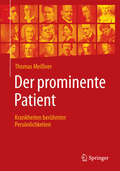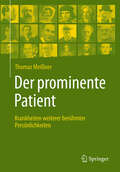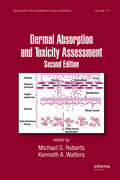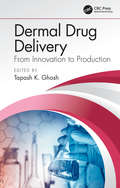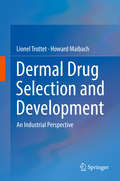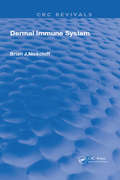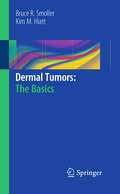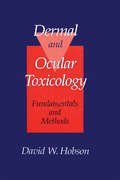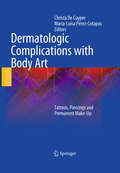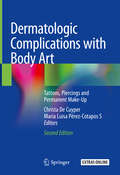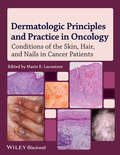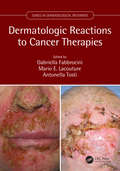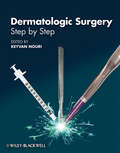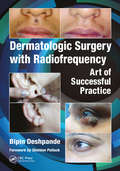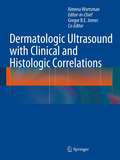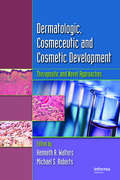- Table View
- List View
Der moderne Krebs - Lifestyle und Umweltfaktoren als Risiko
by Hanna Heikenwälder Mathias HeikenwälderRenommierte Heidelberger Wissenschaftler haben in diesem Buch zusammengetragen, was heute über Krebserkrankungen und ihre Ursachen bekannt ist. Lediglich 5 bis 10% aller Krebserkrankungen werden durch vererbte Gendefekte verursacht. Epidemiologische und experimentelle Daten aus wissenschaftlichen Studien und Hochrechnungen zeigen, wie sehr das Erkrankungsrisiko durch die eigene moderne Lebensweise beeinflusst wird. Die Autoren haben sich zum Ziel gesetzt, diffusen Ängsten und gefährlichem Halbwissen wissenschaftlich valides Wissen entgegenzusetzen und diese Daten und Fakten verständlich und unterhaltsam zu präsentieren. Das Buch richtet sich an alle medizinisch Interessierten, Betroffene und Angehörige.
Der prominente Patient: Krankheiten berühmter Persönlichkeiten
by Thomas MeißnerWie bekannte Persönlichkeiten mit körperlichen und psychischen Leiden umgegangen und wie sie gestorben sind, das ist ein maßgeblicher Bestandteil ihrer Biographien – und fehlt dort meistens. Dieses Werk gewährt Einblick in das Leben von 100 bekannten Persönlichkeiten der Zeitgeschichte, von Martin Luther bis Andy Warhol, von Clara Schumann bis Käthe Kollwitz. Bewegend und fesselnd zugleich schildert der Autor, welche Krankheiten das Leben dieser Menschen prägte, deren Karrieren beendete oder das Lebensende bestimmte.
Der prominente Patient: Krankheiten weiterer berühmter Persönlichkeiten
by Thomas MeißnerNach dem erfolgreichen Buch Der prominente Patient erscheint mit dem vorliegendem Band ein weiteres Werk mit spannenden Krankheitsgeschichten berühmter Persönlichkeiten. Körperliche und psychische Leiden prägten das Leben vieler Prominenter und wurden in ihren Biografien oft ausgeklammert. Das Buch gewährt Einblick in das Leben von 50 bekannten Persönlichkeiten der Zeitgeschichte, von Claude Monet bis Giacomo Puccini, von Jeanne d’Arc bis Steve Jobs. Bewegend und fesselnd zugleich schildert der Autor, welche Krankheiten das Leben dieser Menschen prägten, deren Karrieren beendeten oder das Lebensende bestimmten. Ein Werk mit gut lesbaren Berichten und persönlichen Geschichten, die teils wenig bekannte Details enthalten.
Der ulnokarpale Schmerz: Häufige Differentialdiagnosen und deren Therapie (essentials)
by Christian K SpiesDer ulnokarpale Schmerz entspringt aus einer funktionell äußerst wichtigen Region am Handgelenk. Aufgrund der Komplexität der Strukturen ist einerseits die Kenntnis der Anatomie und andererseits das Verständnis der Biomechanik dieser Gelenkregion essentiell für eine zielgerichtete Untersuchung und Diagnostik. Nach Darlegung dieser Grundlagen werden die häufigsten Differentialdiagnosen, von traumatisch bedingten Läsionen über degenerative Alterationen bis zu angeborene Pathologien vorgestellt und die möglichen konservativen bzw. operativen Therapiemöglichkeiten präsentiert.
Der verborgene Hunger
by Hans Konrad Biesalski Joachim Von BraunIIn Entwicklungsländern ist die Ernährungs-Problematik nicht alleine die unzureichende Versorgung mit Weizen und Reis, sondern die oftmals fehlende Versorgung mit Mikronährstoffen wie Vitaminen und Spurenelementen, die zu massiven Krankheiten (u.a. Blindheit) oder Minderwuchs führen. Selbst bei uns hier in Industrieländern, die wir uns gut ernähren können, treten, was die wenigsten wissen, bei Kindern und v.a. Senioren Mangelerscheinungen auf durch unzureichende Versorgung mit Vitaminen, so beispielsweise bei Vitamin D (geschwächtes Immunsystem; Osteoporose, da Vitamin D die Calcium-Aufnahme fördert). Fotos in Schwarzweiß werten seine Eingangsgeschichten auf.
Dermal Absorption and Decontamination: A Comprehensive Guide
by Howard I. Maibach Aileen M. Feschuk Rebecca M. LawThis book is a comprehensive volume dedicated to dermal absorption and decontamination. Given risks including chemical warfare and accidents with toxic industrial chemicals, studies involving dermal absorption and decontamination are of the utmost importance. Each chapter consists of a systematic review on an important dermal absorption and/or decontamination topic. Chapters address key issues such as the general acceptance of water/ soap and water as the gold standard of dermal decontamination despite the fact that it commonly provides incomplete decontamination and may even result in a “wash-in effect” (an increased penetration of contaminant). Decontamination with other substances (e.g. RSDL) is explored, and factors that affect dermal penetration (e.g. anatomical variation) are summarized. All systematic reviews are comprehensive and up-to-date. Dermal Absorption and Decontamination will be useful for many fields and disciplines. Firstly, information on dermal decontamination may be used by governments for military and national defense purposes in the event of chemical warfare. Additionally, this information would be of use to many production companies, whose employees are at risk of an accident with toxic industrial chemicals. Topics covered in the book will also be of use to pharmaceutical companies, especially those exploring transdermal delivery of drugs and is of great relevance to those in the medical field, particularly dermatologists.
Dermal Absorption and Toxicity Assessment (Drugs and the Pharmaceutical Sciences)
by Michael S. Roberts Kenneth A. WaltersThe source Dermal Absorption and Toxicity Assessment supplies a state-of-the-art overview of the dermal absorption process, and is divided into six well organized sections. Written by internationally recognized experts in the field, this Second Edition is a complete revised and updated text, covering the wide range of methods used to assess skin ab
Dermal Drug Delivery: From Innovation to Production
by Tapash K. GhoshWith the continued advancement of better-quality control and patient outcome reporting systems, changes in the development, control, and regulation of all pharmaceutical delivery systems including transdermal and topical products have been happening on a continuous basis. In light of various quality issues that have been reported by patients and practitioners resulting in the recall or removal of products from the market, both the pharmaceutical industries and regulatory agencies have been adopting new measures to address these issues. With chapters written by experts in this field, this book takes a 21st century multidisciplinary and cross-functional look at these dosage forms to improve the development, design, manufacturing, quality, clinical performance, safety, and regulation of these products. This book offers a wealth of up-to-date information organized in a logical sequence corresponding to various stages of research, development, and commercialization of dermal drug delivery products. The authors have been carefully selected from different sectors of pharmaceutical science for their expertise in their selected areas to present objectively a balanced view of the current state of these products development and commercialization via regulatory approval. Their insights will provide useful information to others to ensure the successful development of the next generation dermal drug products. Key Features: Presents current advancements including new technologies of transdermal and topical dosage forms. Presents challenges in the development of the new generation of transdermal and topical dosage forms. Introduces new technologies and QbD (quality by design) aspects of manufacturing and control strategies. Includes new perspectives on pre-clinical and clinical development, regulatory considerations, safety and quality. Discusses regulatory challenges, gaps, and future considerations for dermal drug delivery systems.
Dermal Drug Selection and Development
by Lionel Trottet Howard MaibachThe authors show how the pharmaceutical industry faces the development of dermal drugs and provide the only book of its kind that describes how the industry develops and selects dermal drugs, complete with the challenges and opportunities of the field. Delivery of drugs through the skin has been an attractive and challenging area for research, and advances in modern technologies have resulted in a larger number of drugs being delivered transdermally, including conventional hydrophobic small molecule drugs, hydrophilic drugs and macromolecules. Offering the perspective from the industrial side of selection and development of drugs, the primary audience is geared towards the pharmaceutical industry but can also offer valuable information to clinicians, compounding pharmacists, and similarly pharmacy students. Dermal Drug Selection and Development covers the scientific gaps that exist in terms of dermal pharmacokinetics and the resulting uncertainty by clinicians when choosing a drug candidate.
Dermal Immune System (Routledge Revivals)
by Brian J. NickoloffFirst published in 1992. Dermal Immune System discusses the structural and functional characterizations of the dermal immune system, including dermal dendritic cells, monocyte/macrophages, microvascular endothelial cells, pericytes, veil cells, fibroblasts, mast cells, dermal T lymphocytes, and peripheral nerve endings. This information is invaluable for gaining an understanding of how multicellular complex networks interface within the dermis and between the exogenous environment and endogenous milieu. Specific examples are provided that document the involvement of the dermal immune system in the pathophysiology of several skin diseases that result from perturbation of normal cutaneous homeostasis.Dermal Immune System is an excellent reference volume that should always be close at hand for immunologists, cell biologists, investigative dermatologists, pathologists, and clinicians involved in the care of patients with skin disease.
Dermal Replacements in General, Burn, and Plastic Surgery
by Lars-Peter Kamolz David LumentaThe skin is the largest human organ system. Loss of skin integrity due to injury or illness results in a substantial physiologic imbalance and ultimately in severe disability or death. The most common cause of significant skin loss is thermal injury, followed by trauma and chronic ulcerations. Over the past decades extraordinary advances have been made in the understanding of cellular and molecular processes of wound healing and the pathobiology of chronic wounds. This knowledge has led to wound care innovations that facilitate more rapid closure of wounds with better functional and aesthetic outcome. A sensible and resource-saving utilization of these innovative technologies requires a broad knowledge of these processes and innovations. This book intends to give an overview about today's wound care developments in tissue engineering and skin replacement. It presents a variety of indications and diversities of clinical applications to help the surgeon select a specific procedure for each clinical situation.
Dermal Tumors: The Basics
by Bruce R. Smoller Kim M. HiattDermal Tumors: The Basics will serve as an effective and efficient handbook for the student of dermatopathology, and as a practical bench reference for the practicing diagnostician who desires rapid access to criteria that are useful in differentiating histologically similar entities. The reader will be able to focus upon a single histologic observation, i.e., inflammatory conditions without epidermal changes, and use this as a starting point from which to build a differential diagnosis based upon pattern recognition. As each entity is addressed, there will be a concise discussion of the basic clinical findings and epidemiologic associations. This will be followed by a histologic description, highlighting areas that serve to discriminate between the entity under discussion and similar ones. Any immunologic studies that might augment the diagnostic sensitivity or specificity will be discussed. The chapters are thematically based and consist of essential bullet points arranged in organized outlines allowing for easy access and direct comparison between entities. The salient histologic features are depicted with abundant high quality, full-color photomicrographs placed immediately adjacent to the appropriate histologic bullet points. This volume will serve as an effective and efficient handbook for the student of dermatopathology, and as a practical bench reference for the practicing diagnostician who desires rapid access to criteria that are useful in differentiating histologically similar entities. The elaborate pictorial documentation will also enable the book to serve as an atlas of the commonest dermatologic disorders.
Dermal and Ocular Toxicology: Fundamentals and Methods
by David W. HobsonDermal and Ocular Toxicology: Fundamentals and Methods is a procedurally-oriented volume of detailed methods and practical examples discussing the dermal and ocular aspects of toxicology. The book is divided into a dermal section and an ocular section. Each section begins with a chapter on the anatomy and physiology of each organ system and then progresses to more specialized chapters discussing such topics as the toxicological pathology of each system, state-of-the-art in vitro and in vivo evaluatory procedures, statistical considerations for test design and data interpretation, and the utilization of test findings. Test methods are provided for acute dermal exposure effects, dermal hypersensitivity and photoallergy assessment, dermal and ocular 0.pharmacokinetics, skin flap and skin grafting techniques, and in vitro alternative methods. This book can be used as an instructional text or as a sourcebook for practicing toxicologists, pharmacologists, industrial hygienists, occupational health professionals, and graduate students.
Dermato-Oncology Study Guide: Essential Text and Review
by Vincent LiuThis book provides clinicians, clinicians-in-training and researchers with a unique rapid-access educational resource on the spectrum of issues at the intersection of skin and malignancy. In it, there is clinical detail provided on how the skin reveals systemic malignancy via cutaneous metastases, genodermatoses or paraneoplastic dermatoses. At the same time, it reviews pharmacologic treatment of internal malignancy and how this can result in cutaneous adverse reactions; conversely, therapeutics for skin conditions can increase risk for internal malignancy. As arguably the most significant cutaneous malignancy, melanoma receives specific attention for its metastatic potential, current diagnostic advances, and recent therapeutic breakthroughs. Dermato-Oncology Study Guide: Essential Text and Review serves a critical educational need for clinicians caring for patients with systemic malignancy by creating an easy-to-use resource that provides practical tools to recognize skin signs of internal malignancy. Furthermore it helps in anticipating and managing adverse reactions of therapeutics for systemic malignancy, and gives the reader the opportunity to weigh the risks of malignancy of pharmacologic agents for skin disease.
Dermatoethics
by Clifford Perlis Lionel BercovitchThere has been a sea-change in dermatology in the last three decades. Managed care, electronic records and communication, cosmetic dermatology, direct-to-consumer advertising, core competencies, and conflicts of interest were either nascent concepts or not even on the horizon as recently as the mid-1980s. The public, accrediting organizations, and physicians themselves recognize the need for training resources in dermatology ethics and professionalism. There is a need to address these topics in a format that will stimulate dialogue and reflection.
Dermatoethics: Contemporary Ethics and Professionalism in Dermatology
by Lionel Bercovitch Jane M. Grant-Kels Clifford S. Perlis Benjamin K. StoffThis extensively updated textbook reviews the ethical issues faced within dermatology. Bringing together practical real-life case scenarios and scholarly analysis, it covers the foundations of bioethics, as well as ethical issues associated with the various roles dermatologists play, including clinician, professional, educator, business person, and scholar. New chapters on the ethics of dermatologic care during pandemics, non-traditional interventions, private equity in dermatology, self-care and improvement, skin cancer screening, maintenance of certification, the ethics of clinical trial design are also included. Dermatoethics: Contemporary Ethics and Professionalism in Dermatology, 2nd Edition creates a dialogue around issues of ethics and professionalism within dermatology and is an essential text for both trainee and practicing dermatologists wishing to immerse themselves in the key questions in the discipline.
Dermatokinetics of Therapeutic Agents
by S. Narasimha MurthyNovel drug delivery technologies strive to bypass challenging biological layers to elicit desired pharmacological activity. The skin, one of our key defensive barriers, allows certain topically applied substances and toxins to pass. The dermatokinetics of a drug determines the efficacy of treatment of skin disorders.Presenting the first compre
Dermatologic Complications with Body Art
by Maria Luisa Cotapos Christa De CuyperBody piercings, tattoos, and permanent make-up have become very popular as a fashion statement in recent decades. This book guides the reader through the world of body art. An overview is first provided of the history and epidemiology of tattoos and piercings. Subsequent chapters go on to examine in detail the materials and devices used in various forms of body art, and the techniques employed. All relevant risks and potential complications are clearly described with the aid of color illustrations. Special attention is paid to allergic reactions and the management of complications. The closing chapter examines the techniques and devices used for tattoo removal, with a particular focus on the use of different lasers.
Dermatologic Complications with Body Art: Tattoos, Piercings and Permanent Make-Up
by Christa De Cuyper Maria Luisa Pérez-Cotapos SOriginally published in 2010, this book has since become one of the seminal works in the rapidly evolving field of body piercings, tattoos, and permanent make-up. Authorities, body art professionals, and the general public have become increasingly aware of the risks associated with these practices and the need for better regulation. This second, extensively revised edition includes an update on the literature and focuses more on the epidemiology and classification of adverse reactions. In particular, it addresses recent findings on tattoo inks, their potential side effects and the initiatives being launched by regulating authorities to reduce the risks related to body art.Dermatologic Complications with Body Art details tattooing procedures in line with the coming European Standards on hygiene (CEN 435 in preparation-release 2018-2019) with extra attention to aftercare. The book features step-by-step video illustrations of different body-art procedures (tattooing, medical tattooing, piercing, and laser tattoo removal). Innovations including medical applications of tattooing are presented. Possible complications, including infections, granulomatous reactions, and allergies are discussed, while new insights on the pathogenesis of allergic reactions are illustrated with the help of recent research data. The book also presents the latest techniques and devices for tattoo removal, together with their risks and benefits. Richly illustrated with videos and pictures, it offers an indispensable guide for dermatologists, physicians and practitioners dealing with body art.
Dermatologic Principles and Practice in Oncology
by Mario E. LacoutureThe first book focusing specifically on frequent and frequently disabling side effects involving the skin, hair and nails in cancer patientsAccording to the World Health Organization, there are approximately thirty million people living with a diagnosis of cancer - the majority of whom will receive surgery, systemic therapy, and/or radiation, and who will suffer from dermatologic adverse events. Dermatologists and oncologists are only beginning to grapple with these events, which pose serious quality-of-life issues with so many patients, and will become more prevalent as survival rates improve, thanks in part to new cancer treatments and drug regimens. Concentrating on a topic that has only been briefly touched upon by other texts, this book offers a focused perspective on the clinical presentation, underlying pathophysiologic mechanisms, and management of skin, hair, and nail conditions for oncologists, dermatologists, and allied practitioners.Dermatologic Principles and Practice in Oncology: Conditions of the Skin, Hair, and Nails in Cancer Patients:* Covers in detail the dermatologic adverse events of oncologic therapies, clinical presentations, and treatment recommendations* Enables dermatologists and other practitioners to significantly improve the care of patients with cancer* Addresses the dermatologic adverse events of cancer therapies used globally, of which a large number are found in developing countries* Emphasizes prophylactic measures - based on treatments used and type of cancer - to prevent the appearance of adverse events* Provides built-in discussions on patient education for practical counseling during therapies* Offers rapid-reference sections on topical dermatology drugsThe first book to present dermatologic conditions in cancer patients and survivors in a uniform and in-depth manner, Dermatologic Principles and Practice in Oncology is ideal for oncologists, oncology nurses, and dermatologists who wish to take better care of those with adverse skin, hair, and nail conditions.
Dermatologic Reactions to Cancer Therapies (Series in Dermatological Treatment)
by Antonella Tosti Mario E. Lacouture Gabriella FabbrociniChemotherapy and radiotherapy for cancer can have devastating side effects on the skin of a patient. This innovative guide for both dermatologists and oncologists gives a good introduction both to therapy regimes and to dermatological management for medical professionals treating their patients.
Dermatologic Surgery
by Keyvan NouriThis manual offers detailed, step-by-step guidance to dermatologic surgical procedures. The coverage provides three main sections - General Dermatologic Surgery, Cosmetic Surgery, Lasers and Miscellaneous topics - over 60 chapters with a concise templated format. Each chapter features five sections: pre-operative care, step by step surgical technique, post operative care and follow up, complications, and prevention and management of complications. Filled with clear descriptions and illustrations (5-10 per procedure), this manual and accompanying DVD provides physicians with updated and easy-to-read information for quick review and reference. CD-ROM/DVD and other supplementary materials are not included as part of the e-book file, but are available for download after purchase.
Dermatologic Surgery with Radiofrequency: Art of Successful Practice
by Bipin DeshpandeThis book offers useful insight into the new dermatologic surgical applications of radiofrequency, besides elaborating the basic applications of the same exhaustively. This book will also provide invaluable practical inputs for the skillful management of surgery in Dermatology and Aesthetic practice.
Dermatologic Ultrasound with Clinical and Histologic Correlations
by Gregor Jemec Ximena WortsmanSignificant technological advances have produced equipment that allows imaging of the skin with variable frequency ultrasound in previously unseen detail and provides a range of dynamic data that is currently unmatched by any other technology. Dermatologic Ultrasound with Clinical and Histologic Correlations is a comprehensive introduction to ultrasonography of the skin, nails, and scalp as it relates to the assessment and diagnosis of dermatologic diseases. It provides radiologists, sonographers, dermatologists, and physicians with interest in skin imaging with a concise understanding of the diagnosis of dermatologic conditions through extensive high-resolution gray scale and color Doppler ultrasound images and presents classical correlations of clinical dermatologic lesions with sonographic and histologic findings. Featuring more than 1700 images, this text-atlas provides an excellent starting point in learning about this topic. Featuring contributions from world-renowned authorities in the field of superficial ultrasound imaging, the book reviews the technical considerations relating to color Doppler ultrasound of the skin; surveys the dermatologic entities that can be visualized with ultrasound imaging, such as cutaneous tumors, inflammatory diseases, hemangiomas and vascular malformations, melanoma, nail tumors, scalp diseases and cosmetic conditions; shows common simulators of cutaneous diseases; and discusses protocols for assessing common dermatologic conditions. Inclusion of clinical overviews, tips, and pitfalls enables a better understanding of the pathologies of the disorders and the methodological approach in assessing these entities.
Dermatologic, Cosmeceutic, and Cosmetic Development: Therapeutic and Novel Approaches
by Arthur C. OuwehandRecent advances in our understanding of the development and morphology of normal skin have led to improved methods to deliver therapeutic compounds to targeted areas both within the skin and systemically. This reference provides a clear overview of pharmaceutical and cosmetic practices, drugs, and therapies to manage and treat major and minor skin disorders. It examines the efficiency and delivery of topical therapies and explains how percutaneous absorption is affected by age, skin, site, race, skin disease, and damage and product form. Particular emphasis is on novel treatment approaches for major skin diseases and injuries pertaining to wounds and burns.

